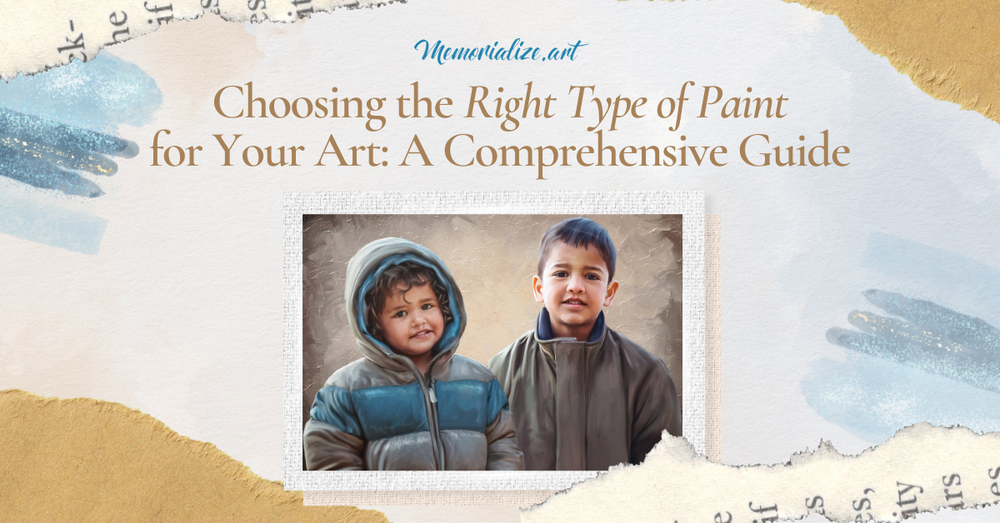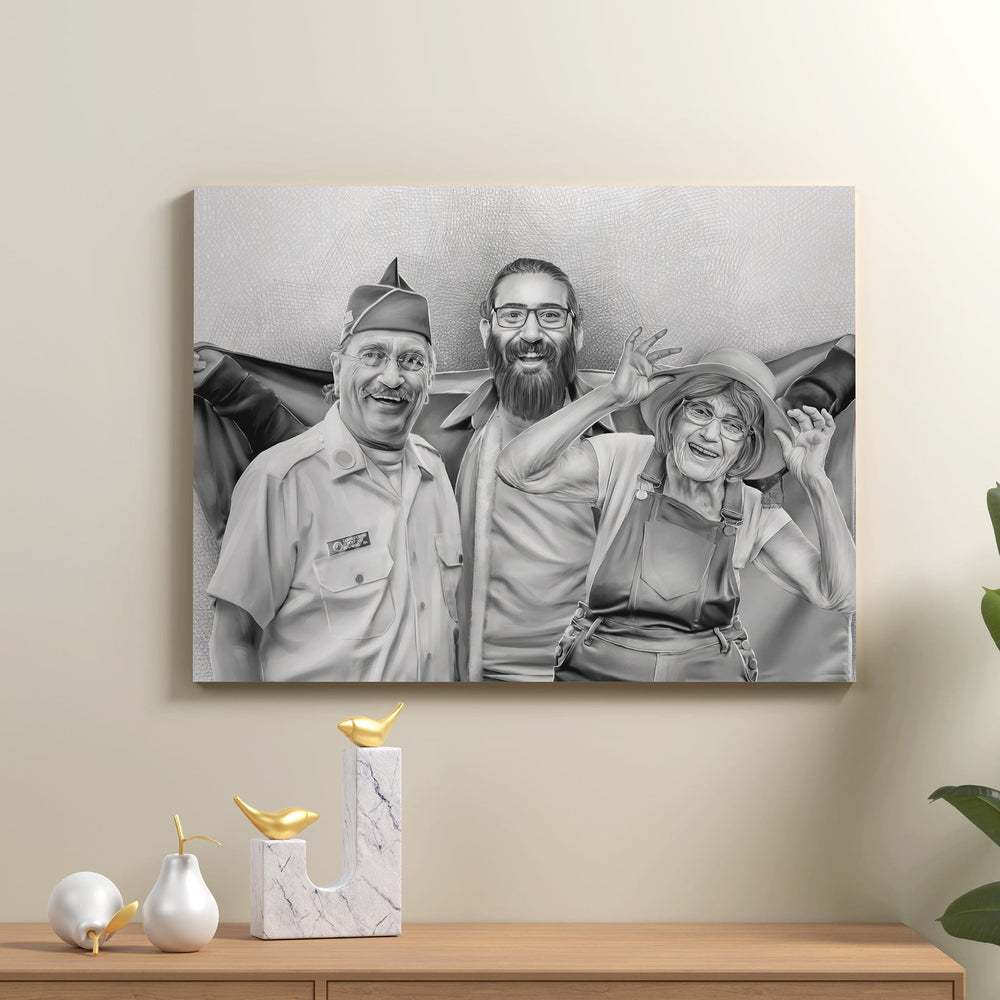Choosing the Right Type of Paint for Your Art: A Comprehensive Guide

Are you eager to bring your artistic vision to life but unsure about which paint to use? Whether you're a beginner or an experienced artist, it's crucial to understand the different types of paint and how they can influence your art.

Each type of paint has its unique characteristics. From how long it takes to dry to the texture it creates and even how vibrant the colors can be - these factors all play a role in shaping your final piece of art. By understanding these differences, you can choose the right paint that matches your style and brings your creative ideas to life.
In this guide, we will introduce you to five popular types of paint: acrylics, oils, watercolors, gouache, and pastels So, whether you're interested in the bold colors of acrylics or the soft subtlety of watercolors, you'll find all the information you need right here.
Five Types of Paint For Art
Art is a world full of colors, textures, and techniques. One of the most critical aspects of creating beautiful artwork is choosing the right type of paint.
Each type of paint has unique qualities that can enhance your work differently. Let's delve into the characteristics, benefits, and uses of five popular types of paint for art: Acrylic, Oil, Watercolor, Gouache, and Encaustic.
Acrylic
Acrylic paint is one of the most versatile and widely used mediums in the art world. It's known for its bright, vibrant colors and quick drying time. This type of paint is water-soluble when wet but becomes water-resistant once dry. Its fast-drying nature allows artists to layer paint quickly, making it ideal for techniques like impasto and collage.
Acrylics are suitable for various surfaces, including canvas, paper, wood, and even fabric. They're easy to clean up with water and have low toxicity levels compared to oil paints. However, because they dry so quickly, they may not be the best choice for blending techniques or slow, detailed work.
Oil
Oil paints are renowned for their rich, buttery texture and long drying time. They offer a depth of color that is hard to match with other types of paint. Because they dry slowly, artists have ample time to blend colors and make changes. It makes oil paints perfect for realistic portraits and landscapes where subtle gradations of color are required.
Oil paints require solvents for clean-up and can be used on prepared canvases to prevent them from being degraded by the oils. They are loved for their unparalleled depth and luminosity, but keep in mind that working with oils requires patience as they can take days, weeks, or even months to fully dry.
Watercolor
Watercolors are known for their delicate, transparent layers and the fluidity they bring to artwork. They are water-soluble, even when dry, which allows for unique effects like washes, gradations, and soft blends. Watercolors are typically used on specific watercolor paper that can handle the water and allow the colors to flow and blend.
While watercolors may seem daunting due to their unpredictable nature, they are excellent for expressing light and atmosphere in landscapes and portraits. However, they require a fair amount of control and planning, as mistakes can be hard to correct.
Gouache
Gouache (pronounced 'gwash') is often described as a cross between watercolor and acrylic paint. Like watercolors, it is water-soluble, but it dries to a matte finish like acrylics. Gouache is known for its creamy consistency and vibrant, opaque colors.
The opacity of gouache makes it ideal for adding detailed layers on top of other paints. It's also great for creating bold, flat areas of color. Gouache can be used on various surfaces, including watercolor paper, illustration board, and canvas. However, it can reactivate when painted over, which requires careful layering.
Encaustic
Encaustic paint, made from beeswax, resin, and pigment, is a less common but fascinating type of paint. It's heated until liquid and then applied to a surface, usually wood. As it cools, it creates a lustrous, enamel-like finish that can be polished to a high gloss.
Encaustic painting requires specialized tools and careful handling due to the use of heat. It allows for unique techniques like carving, layering, and embedding objects.
While encaustic painting is not as widespread as other types, it offers artists an exciting range of textures and effects. However, it may not be suitable for beginners due to its complex process and potential safety considerations.
Examples
An artist's choice of paint can significantly influence the style and impact of their artwork. To help you visualize how different types of paint can be used, let's look at some examples from Memorialize Art, where we have a diverse range of artistic styles and mediums.
Acrylic Portrait

Acrylic is a popular choice for portraits due to its versatility and vibrant color palette. An excellent example from our portfolio at Memorialize Art is an acrylic portrait that showcases our ability to capture intricate details and subtle skin tones.
We use the fast-drying nature of acrylics to layer colors and create depth, resulting in a lifelike representation that seems to jump off the canvas. Our use of acrylics in this portrait allows for sharp contrasts and vivid colors that make the subject stand out.
Watercolor Portrait

Watercolor portraits from Memorialize Art demonstrate the unique qualities of watercolor paint. These artworks often feature soft, flowing colors and a dreamy, ethereal quality.
In one such portrait, we beautifully capture the light and shadow on the subject's face using delicate washes of color. The transparency of watercolors allows us to build up layers of color, creating a sense of depth without losing the luminosity that characterizes watercolor paintings.
Pet Oil Painting

Oil paints are ideal for capturing the texture and richness of a pet's fur. A pet oil painting from Memorialize Art showcases our ability to depict realistic details and deep, vibrant colors.
We skillfully use the slow drying time of oils to blend colors seamlessly, capturing the glossy sheen of the pet's coat and the expressive details in its eyes. The painting has a depth and realism that is characteristic of oil paintings.
Acrylic Dog Painting

Acrylic paints are also widely used for pet portraits. An acrylic dog painting from Memorialize Art demonstrates how we can use this medium to capture the energy and personality of a pet.
We use bold, bright colors and sharp contrasts to bring the dog's playful nature to life. The quick-drying nature of acrylics allows us to work fast, layering colors while they are still fresh to create a dynamic, textured effect. The result is a vibrant, lively portrait that captures not only the dog's likeness but also its spirit.
Types of Painting Styles (and which paint to use for them)
The world of art is as diverse as it is beautiful, with numerous painting styles that artists use to express their creativity. Each style has its unique characteristics and often calls for a specific type of paint to bring out its full potential. Here are five common painting styles and the types of paint best suited for them.
Realism
Realism focuses on depicting subjects accurately and truthfully, just as they appear in real life. The style requires a high level of detail and subtle color variations, making oil paint an excellent choice.
The slow drying time of oil paints allows for seamless blending of colors, capturing the intricate details and depth that realism demands.
Impressionism
Impressionism is characterized by loose brushwork and vibrant colors. The goal is not to create a realistic depiction but to capture the impression of a moment. Acrylic paints, with their bright hues and quick-drying nature, are perfect for this style.
They allow artists to work quickly, layering colors while still fresh, to create the characteristic soft and fluid appearance of Impressionist paintings.
Abstract
Abstract art does not attempt to represent an accurate depiction of visual reality. Instead, it uses shapes, colors, forms, and gestural marks to achieve its effect. Both acrylics and oils can be used for abstract painting, depending on the desired result. Acrylics offer bold colors and sharp lines, while oils provide depth and texture.
Watercolor Painting
Watercolor painting is a style that uses the transparency of watercolors to create a light, airy effect. It's often used for landscapes and portraits where a delicate touch is needed. As the name suggests, watercolor paint is the go-to choice for this style, allowing artists to create soft washes of color and subtle gradations.
Pop Art
Pop Art is a modern art style that draws inspiration from commercial and popular culture. It's known for its bold, bright colors and simple shapes.
Acrylic paint, with its vibrant palette and quick drying time, is perfect for Pop Art. It allows artists to create clean lines and flat areas of color typical of this style.
Unleash Your Artistic Potential with Memorialize Art Today!
Art is a journey of self-expression, and choosing the right paint can make all the difference in your artistic journey. Whether you're a seasoned artist or just starting, understanding the different types of paints and their best uses can help you create artwork that truly expresses your vision.
At Memorialize Art, we offer various painting styles and mediums to suit every preference. Our skilled artists are adept at using different types of paints to bring out the best in every style, from the subtle hues of watercolor landscapes to the bold colors of acrylic pop art.
Explore our portfolio today, and let us help you bring your artistic vision to life.
Frequently Asked Questions
Which is the most common art paint used?
Acrylic paint is commonly used due to its versatility and ease of use.
Which types of painting styles are best done with Acrylic paint?
Acrylic paint is ideal for Pop Art, Abstract Art, and Impressionism due to its vibrant colors and quick-drying nature.
What is the most common art paint?
Acrylic paint is often the most common choice due to its versatility and affordability.
What Are the More Popular Painting Styles?
Popular painting styles include Realism, Impressionism, Abstract, Expressionism, and Pop Art.










